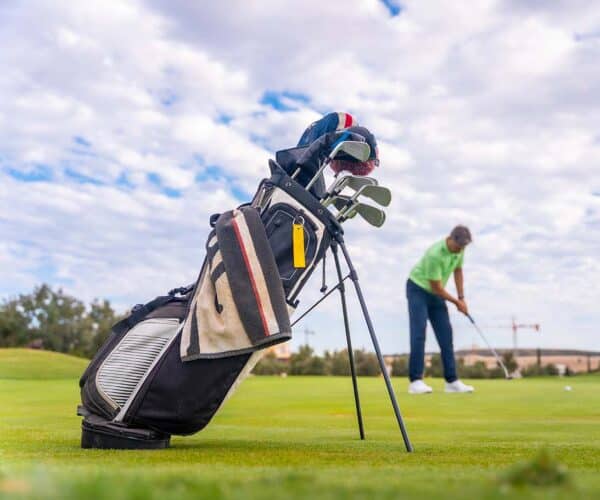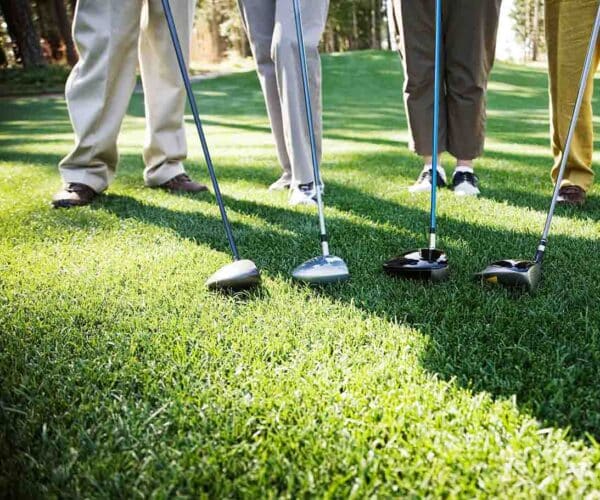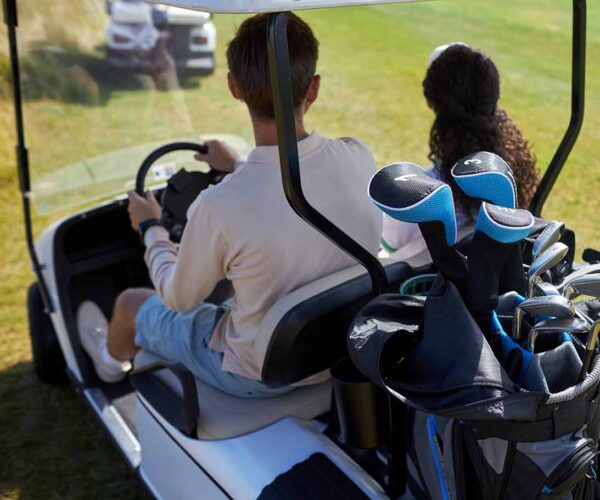For many golfers, their clubs are more than just tools or equipment, they’re trusted companions on the course, carefully chosen over time and often with a significant financial investment. But across the UK, theft of golf equipment is on the rise, and many golfers are discovering – too late – that they’ve become easy targets.
In this blog, we’ll explore the scale of the problem of golf club theft, share some recent incidents and eye-opening statistics, highlight where and how thefts most commonly occur, and provide advice on protecting your gear and securing the best golf insurance. Whether you’re a weekend golfer or a club regular with top-spec equipment, there’s never been a better time to get serious about security.
The rising threat of golf club theft in the UK
You might think it’s a rare occurrence, but the reality is far more concerning.
According to a recent UK-wide survey, approximately 183,000 golfers fell victim to either theft or damage of their equipment over just a two-year period. And the most recent industry-wide data available (from 2020) estimated that golf-related thefts cost the UK around £10 million. With club prices rising and custom gear more popular than ever, that figure is likely even higher today.
Looking at our own golf insurance claims data; in 2024 13% of claims were from golf equipment theft. Whilst the incident might not top this leaderboard – out of the top 50 most expensive claims paid out, 62% were from golf club theft.
Where and how golf equipment is stolen

Sadly, golf gear theft has been alarmingly common across the UK. Thieves are opportunistic, quick, and well aware of the value in golf clubs and related equipment. Based on recent news and our own data, these are where the risks are most significant:
In and around cars
Leaving clubs in your car—whether during a round or overnight—is a major risk. Criminals often monitor popular course car parks and local driving routes.
Sheds, garages, and outbuildings
Storing clubs at home may seem sensible—but detached sheds or shared garages are prime pickings for thieves. A single break-in can leave you without your entire kit.
On the course or in the clubhouse
Even a brief stop at the halfway hut or locker room can be enough. Unattended bags have been stolen during a quick coffee break or chat.
Common raids
Thieves typically operate in two main ways: through quick, opportunistic “smash and grab” thefts, often targeting cars and lockers and completed within minutes, or through more organised raids, where multiple locations such as vans and course outbuildings are targeted in coordinated efforts. CCTV footage has frequently captured how swiftly and efficiently these crimes are carried out.
It’s not just the clubs; high-value gear like GPS rangefinders, electric trolleys, premium bags, and branded apparel is also a frequent target. Thieves know that gadgets can be sold quickly and discreetly.
A growing black market for golf gear
One of the reasons golf equipment theft has increased is because of the resale value. High-end drivers, custom irons, and new putters can fetch hundreds (sometimes thousands) of pounds on resale markets, especially if the buyer doesn’t ask many questions.
Stolen clubs are commonly sold through:
- Online marketplaces and auction sites.
- Pawn shops or second-hand stores.
- Informal networks – golf forums, car boot sales, even local ads.
With no universal registration system for clubs, tracking stolen items is incredibly difficult, and once they’re sold on, recovery becomes almost impossible.
How the industry and law enforcement are responding
The good news is that steps are being taken. There have been notable investigations and arrests, with law enforcement beginning to recognise golf theft as more than just low-level crime.
One promising initiative is Immobigolf, a registration system that allows golfers to log serial numbers and details of their equipment. If a registered item is found or listed for sale, it can be flagged and returned to the rightful owner. The more golfers use these types of systems, the harder it becomes for criminals to offload stolen goods without detection.
Retailers and manufacturers are also being urged to assist with crime prevention, such as by adding serial tracking to new clubs and working with police on suspicious transactions.
Practical tips to keep your clubs safe

When it comes to protecting your golf equipment, taking a few proactive steps can go a long way. Golf club theft is often opportunistic, and simple precautions are often enough to deter would-be thieves. Whether at home, on the course, or in transit, here’s how you can keep your gear safe:
Be mindful of your car
Avoid leaving clubs in your car whenever possible, even for short periods or while running quick errands. If you have no other option:
- Always lock your vehicle and ensure clubs are completely out of sight, preferably in the boot.
- Choose a well-lit, busy area or park in a location with CCTV coverage if you’re near a clubhouse or driving range.
- Consider investing in window tints or a vehicle alarm system for added protection.
Store clubs securely at home
At home, don’t leave clubs visible in shared garages, open sheds, or communal areas:
- Ideally, store them inside your home or in a locked garage with a strong door and alarm.
- If you use a shed, install deadbolts and motion-sensor lighting nearby to discourage break-ins.
- For added peace of mind, you can use a heavy-duty cable lock to secure your bag to a fixed point indoors.
Stay alert on the course
It only takes seconds for someone to walk off with an unattended bag:
- Never leave your bag outside the clubhouse or on the course while you grab a coffee or visit the pro shop.
- If you’re using a buggy, don’t assume it’s safe when parked near the green, always keep your gear in sight.
- Be wary at open competitions or charity events, where foot traffic is higher and security looser.
Mark and track your gear
Property marking is one of the most effective deterrents, especially if your clubs are stolen and later recovered:
- Use UV pens or permanent markers to label your clubs with initials or a postcode.
- Consider RFID tags or smart trackers that can be linked to your phone, particularly for high-value sets.
- Services like Immobigolf or other online club registries can help police identify stolen gear if it turns up.
Document everything
Should you ever need to make an insurance claim, you’ll need to prove ownership and value:
- Keep digital copies of receipts, order confirmations, and warranty documents.
- Photograph each club individually, showing make, model, and any custom features (grips, shafts, etc.).
- Store these records somewhere secure, ideally both on your computer and backed up to the cloud.
Know your club’s locker policy
If your club offers locker storage, don’t assume it’s theft-proof:
- Ask staff about security protocols such as – are lockers monitored by CCTV? Are they routinely checked?
- Confirm whether theft from club lockers is covered under any group insurance or if you’re expected to insure your own gear.
- If lockers use shared or simple locks, consider using a sturdier padlock or security bar of your own.
What to do if your golf clubs are stolen

Despite your best efforts, theft can still happen and knowing how to respond quickly can improve your chances of recovery and make the claims process smoother.
1. Report the theft immediately
- Contact the police as soon as you discover the theft. Provide a full description of the stolen items, including makes, models, serial numbers (if available), and any distinguishing features.
- Ask for a crime reference number — this will be essential for any insurance claim.
2. Inform your golf club or facility
- If the theft occurred on club grounds or during an event, notify the club manager or pro shop. They may have CCTV footage or information about other recent incidents.
- Some clubs have insurance or procedures in place to assist affected members.
3. Check nearby CCTV or witnesses
- If the theft happened at a car park, driving range, or clubhouse, check for surveillance cameras nearby.
- Ask around – someone may have noticed suspicious behaviour or captured footage on a dashcam or mobile phone.
4. Notify your insurance provider
- Contact your golf insurer or home insurance provider (if your policy covers golf gear) as soon as possible.
- Be prepared to provide:
- A police crime reference number
- Proof of ownership (receipts, photos, serial numbers)
- Evidence of forced entry or reasonable care (e.g. photos of damaged locks or smashed windows)
5. Monitor online marketplaces
- Keep an eye on local selling platforms such as eBay, Facebook Marketplace, Gumtree, and second-hand sports shops. If you spot your gear, report it to police – do not attempt to recover it yourself.
6. Register the theft online
- If you’ve used services like Immobigolf, update the status of your equipment as stolen.
- Some social media groups and forums for golfers have stolen item alerts, sharing details there may increase your chances of recovery.
Insurance: Why golf-specific cover matters
A surprising number of golfers assume their clubs are covered by their home insurance, and while this may be true, the cover is often basic, with high excess fees, strict exclusions, and no replacement guarantee.
Dedicated golf insurance policies are designed with players in mind. Here’s why they’re worth considering:
- “New-for-old” cover: If your gear is stolen or damaged, you’ll get a current equivalent — not a depreciation-adjusted amount.
- Wider cover: Most policies include theft, accidental damage, third-party liability, and even personal injury.
- Faster claims process: With proper documentation, claims are often more straightforward than through household insurers.
It’s important to check the terms carefully. Typically, insurance won’t cover unattended equipment or theft without forced entry. Also, high-end sets, especially custom or premium brands, can be worth £2,000 to £5,000+, so make sure your policy covers the full replacement value.
To ensure you’re protected:
- Register your gear where possible.
- Keep your documents organised.
- Store equipment safely and lock it up — both at home and at the club.
Stay smart, stay safe
Golf club theft is no longer a rare or unlucky occurrence; it’s a growing problem that demands attention. By being vigilant, securing your gear properly, and considering dedicated insurance, you can protect your investment and enjoy the game without worry.
Whether you’re a scratch player or a weekend warrior, the message is the same: take your golf club security seriously.
Golf Insurance from SportsCover Direct
5-star rated reviews from thousands of happy customers
Secure Specialist Golf Insurance from SportsCover Direct
With golf club theft costing UK golfers millions each year, specialist golf insurance is essential. High-value sets are prime targets, and having the right cover ensures you’re protected against the financial hit if your equipment is stolen.
SportsCover Direct’s golf insurance is designed to protect you, your financial wellbeing, and your equipment. If you cause injury or damage to another person during a round of golf, our cover includes legal fees and any necessary damage payouts. Additionally, there’s cover for up to £250 of clubhouse drinks if you land a hole-in-one.
Our policy also gives the option of up to £7,500 of protection against equipment theft, loss and damage; just choose your preferred level of cover. Plus, our personal accident cover offers protection for potential legal and medical expenses in the unfortunate event of accidentally causing injury or property damage.
Find out more and get a quote tailored to your needs. Contact our team if you have any questions.
This blog has been created as general information and should not be taken as advice. Make sure you have the correct level of insurance for your requirements and always review policy documentation.